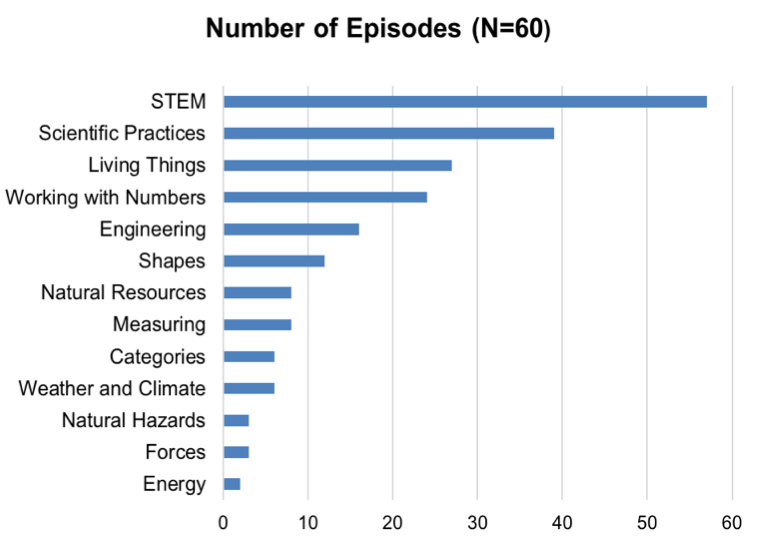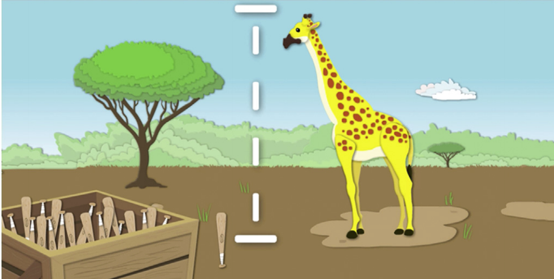Insights on children’s STEM learning through media
This is a guest post written by Kelly Sheehan, Alexis Lauricella, and Ellen Wartella from the Center on Media and Human Development at Northwestern University.
More than 40 years of research suggests preschool-age children can learn from high-quality, educational television programs, such as Sesame Street and Blues Clues. But the rise in children’s use of newer forms of media, including touchscreen apps, online videos, and voice-control systems, has reignited the public’s discussion on the educational value of media for young children: Can young children learn educational concepts from watching a television show or playing a game or app?
At the Center on Media and Human Development, we have conducted surveys, experiments, and evaluations to understand how to best support preschool children’s learning of science, technology, engineering, and mathematics (STEM) from media. We were motivated to conduct this research because children’s learning of STEM in the preschool years is critical to their engagement in these fields later in life. Moreover, media can be a powerful learning tool for children before they enter Kindergarten, exposing them to novel concepts they might not otherwise be exposed to (like erupting volcanoes or underwater life) and potentially sparking their interest by making learning engaging. Despite the recent discourse on the potential negative effects of media on children’s lives, our team of communication scientists and developmental psychologists sought to conduct research on how media can augment young children’s out-of-school STEM learning and empower parents to engage their children in STEM learning early in life.
Understanding the STEM Media Landscape

The first step in undergoing this research was to first understand what STEM learning opportunities were available on children’s media. We identified all the shows on cable television in the United States geared toward preschool children that claimed to teach STEM (20 shows), and we analyzed three episodes from each show for science and math content using Next Generation Science Standards and Common Core Standards. We found that all the shows we analyzed taught at least one STEM content area, but there were large differences in what content areas were represented. For example, two-thirds of the episodes taught scientific practices, like asking questions and testing hypotheses, but only two shows discussed concepts like force and energy. Therefore, there seem to be opportunities to increase the breadth of topics presented on STEM television for children.
We also wanted to know how the characters are represented in these STEM shows, since television can implicitly teach children who engages in STEM learning or has a STEM career. We therefore analyzed the demographics of characters on these shows and found that female and minority characters were underrepresented, especially for secondary characters. These results give us a better understanding of how STEM is represented on children’s television but also call for a greater diversity of characters to be represented.
The Role of Parents in Their Children’s STEM Learning from Media
With a better understanding of the STEM media landscape, we then sought to understand how parents engaged their preschool children in STEM learning. Parents play an important role in their children’s learning in the preschool years, so understanding their attitudes and behaviors around STEM was critical to understanding how their children engaged with STEM media for learning.
In a large online survey, we investigated the relation between parent involvement with STEM, their children’s use of STEM media, and their children’s STEM learning (publication coming in August 2018). We had two major findings from this research: First, parents undervalued science and math compared to reading, writing, history, art, and physical education, suggesting there may be opportunities to boost parent attitudes about the importance of STEM early in life. Second, we found that families who had a member with a STEM career actually used less STEM media but reported their children had high science and math skills. For non-STEM career families, children who consumed the most STEM media reportedly had worse science and math skills. Although this research was correlational, it suggests there may be important relations between parent expertise and comfort around science and math and how they use media for STEM learning. We explored this possibility further by conducting a small number of semi-structured interviews with parents of preschoolers and found that parents did discuss their involvement or career in STEM as a motivator for engaging their child in STEM. Parents also discussed using science and math media as a reinforcement tool rather than for teaching new concepts, which gave us a more nuanced understanding of the role of media in families’ lives.
Children’s STEM Learning from Touchscreens
 With a better understanding of the context during which children use STEM media, we conducted a number of studies and evaluations aimed at understanding if preschool children can learn STEM-related content and skills from STEM touchscreen apps and games. For these studies, we asked preschoolers to play with an app and then we assessed their learning. In the first study, we found that children could learn to measure different objects depicted on the screen by playing a game or by watching a video on a touchscreen. Importantly, we also found that children’s learning of measuring generalized off-screen to pictures of other objects when they watched the video rather than played the game, suggesting interactivity may be better for direct application of learned skills.
With a better understanding of the context during which children use STEM media, we conducted a number of studies and evaluations aimed at understanding if preschool children can learn STEM-related content and skills from STEM touchscreen apps and games. For these studies, we asked preschoolers to play with an app and then we assessed their learning. In the first study, we found that children could learn to measure different objects depicted on the screen by playing a game or by watching a video on a touchscreen. Importantly, we also found that children’s learning of measuring generalized off-screen to pictures of other objects when they watched the video rather than played the game, suggesting interactivity may be better for direct application of learned skills.
In the second study, we had parents and their children play a coding app together and measured the quality of their interactions. We found that certain interactions, like task-relevant talk, was positively related to children’s learning, suggesting that when parents direct their children’s attention during play, it can help them learn more from the game.
Lastly, we conducted an in-classroom evaluation of a week-long summer camp aimed at teaching coding via two coding apps for preschool-age children. We found that children did improve in their game-specific coding skills and that their enjoyment of the games predicted how much they learned. These studies not only show that children can learn from STEM apps, but suggest specific factors, like staying on task and enjoyment, are important for maximizing children’s learning.
Insights and Next Steps
Media undoubtedly pervades the lives of young children, but our research can help researchers, educators, parents, and media producers understand the role of media in children’s informal STEM education. We see our results as having multiple implications for future research and application. For example, researchers can expand on our findings by analyzing the STEM apps available for preschoolers and evaluating the concepts they claim to teach. Practitioners can use our results to help parents understand the importance of STEM learning at early ages or design interventions to promote parent comfort around STEM. Lastly, media producers can draw on our results to design apps that are not only engaging but promote high quality parent-child interactions. We hope these results expand the field’s understanding of children’s informal learning of STEM through media and prompt the broader community of informal science professionals to continue seeking ways through which STEM media can be part of the informal learning process.